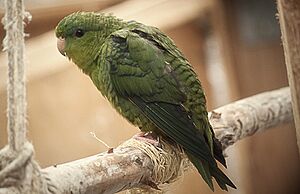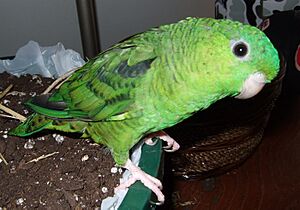Barred parakeet facts for kids
Quick facts for kids Barred parakeet |
|
|---|---|
 |
|
| Conservation status | |
| Scientific classification | |
| Genus: |
Bolborhynchus
|
| Species: |
lineola
|
| Subspecies | |
|
B. l. lineola (Cassin 1853) |
|
 |
|
The barred parakeet is a small, colorful bird. It's also known as the lineolated parakeet or "Linnie" for short. You can find these parrots in the mountain forests of warm places in Latin America.
Linnies are mostly green. They have cool black or dark green stripes and bars on their bodies. Their beak is a light, peachy color. The stripes can look different on the two types of barred parakeets. People love them as pets because they come in many different colors!
These birds live in different, separate areas. You can find them from southern Mexico down to Panama. In South America, they live in the Santa Marta Mountains of Colombia and the Venezuelan Coastal Range. They also live in the forests near the Andes mountains, from western Venezuela all the way to Peru and Bolivia.
Contents
Meet the Barred Parakeet Family
There are two main types, or subspecies, of the barred parakeet:
- Bolborhynchus lineola lineola
- Bolborhynchus lineola tigrinus – This one is called 'tigrinus' because it has more noticeable dark stripes, like a tiger!
What Do Barred Parakeets Look Like?
The barred parakeet is about 16 centimeters (6.5 inches) long. It weighs about 42 to 52 grams, which is like a few strawberries.
Most of its body is green. It has black stripes on its upper parts, but not on the top of its head. Its belly is olive-green with very dark green stripes on its sides. The top of its wings near its body is black. There's some blue under its wings, and its tail is dark green.
Their eyes are dark brown, and their beak is a horn color. Their legs are pink. Young birds have lighter stripes, which get darker as they grow up. It's hard to tell males and females apart just by looking at them. Sometimes males have slightly darker stripes.
Where Barred Parakeets Live
Barred parakeets live in forests and mountains. They can be found as high as 3,300 meters (about 2 miles) above sea level. They spend some time on the ground, but they sleep high up in trees. These birds can handle cold weather. They have even been seen taking baths in the snow!
There are many barred parakeets in the world. Their numbers seem to be staying steady.
Barred Parakeet Behavior and Babies
Female barred parakeets usually lay two to four eggs. The eggs hatch after about 18 to 21 days. The baby birds leave the nest when they are about five weeks old.
In the wild, barred parakeets usually live in groups of six to thirty birds. Sometimes, much larger groups of up to 150 birds have been seen! They like to eat fruits, dried seeds, sprouted seeds, and even insect larvae.
Linnies are known for being calm and quiet birds. They often rest in a flat, horizontal position. Their heads are almost in line with their tails. They usually make soft, mumbling sounds. Their calls are not loud or annoying.
Barred Parakeets as Pets
Barred parakeets are popular pets. This is because they are calm and gentle. Also, they come in many cool color variations!
Green colored birds include the normal green (like in the wild), dark green, and olive. There's also a yellow one called a lutino. Blue colored birds include turquoise, cobalt, and mauve. There's even a white one called a creamino. Some birds have "greywing" which means their stripes and colors are lighter.
Linnies usually live for about 10 years. Some have lived up to 15 years! They are also good at copying human speech.
- Colour mutations
Bathing and Hiding Fun
One fun thing about barred parakeets is how much they love baths! They enjoy being sprayed with water. When they get a mist bath, they might hang upside down and spread their wings.
Pet linnies also have a unique habit. They love to burrow or hide in or under clothes for hours! Sometimes they even fall asleep in their cozy hiding spots.
Learning to Talk
Barred parakeets are known for their soft chirps and low noise levels. This makes them great pets for apartments. They can sometimes make louder noises, but this usually means they are upset or their food dish is empty.
These birds can also learn to talk and copy sounds. Not all of them will speak. Males are usually more vocal. Here are some ways to help a bird learn words:
- Start when they are young. They learn the most words when they are less than two years old. They also learn well when they are in a new home.
- Play imitation games. Start by rewarding them when they copy a sound they already make. Then move on to words or new sounds.
- Say phrases in an excited voice. Do this when the bird is also excited.
- Let your bird spend time with another bird that already talks. This is especially helpful if it's the same kind of bird.
Sometimes, linnies will copy the tone of a specific person's voice. This is usually the person they spend the most time with. They might also learn to copy sounds you don't want them to repeat. To stop unwanted sounds, don't give them attention or laugh. Instead, try to get them to do another trick.
Food for Pet Barred Parakeets
Pellets are a great main food for pet barred parakeets. They have many important vitamins and nutrients birds need. Seeds should be a small part of their diet, not the main food. Too many seeds can make birds overweight, unhealthy, and cause kidney problems.
Green leafy vegetables like kale, collard greens, and turnip greens are good. They also enjoy broccoli, carrot, and cauliflower. Common fruits they can eat include banana, papaya, apple, apricot, and orange. Other safe foods are hemp seeds, roasted soybeans, potatoes, green peas, strawberries, coconut, pumpkin seeds, and alfalfa. It's good to offer different foods to keep their diet balanced. All pet parrots should be encouraged to search for their food. This helps keep them from getting bored and having behavior problems.
Foods to Avoid for Pet Birds
Owners should never feed their birds foods high in salt, sugar, or fat. Some common foods that are bad for birds include:
- Avocado and guacamole
- Things with caffeine, like tea and coffee
- Fruit pits and apple seeds (they have small amounts of cyanide)
- Persimmons
- Onions (eating too many can cause a blood problem)
- Mushrooms (can cause digestion problems and liver damage)
- Dried or uncooked beans (they have something toxic to birds)
- The stems, vines, and leaves of tomatoes (the red fruit part is fine)
- Eggplant







